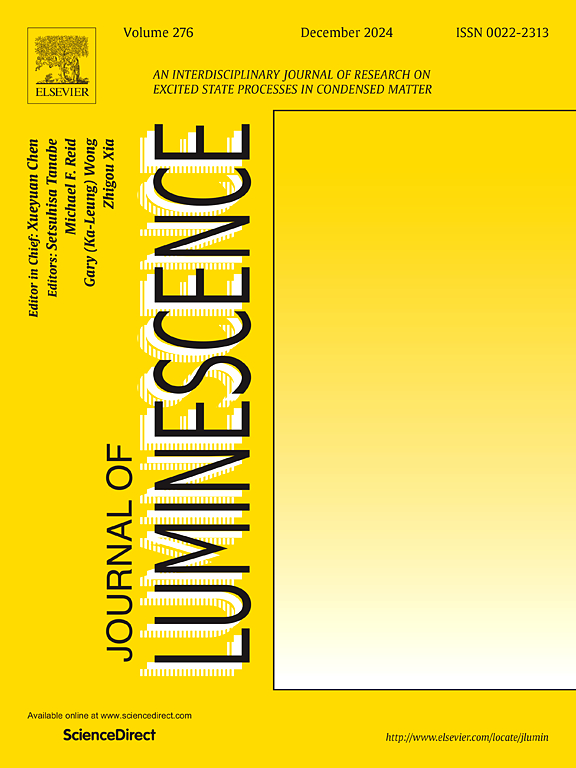利用高折射率材料基光提取层提高蓝色热激活延迟荧光有机发光器件的效率
IF 3.3
3区 物理与天体物理
Q2 OPTICS
引用次数: 0
摘要
将一种基于氮化硅(Si3N4)的高折射率周期孔结构引入到热激活延迟荧光(TADF)有机发光二极管(oled)中,以提高其光学效率。由于其高折射率,氮化硅作为一种有效的光学散射介质,增强了oled中的光提取。利用激光干涉光刻技术(LIL)实现了高折射率结构(HRS),该结构定义了光致抗蚀剂(PR)层中的周期性图案。这种图形化的PR层随后作为蚀刻掩膜,允许将纳米结构直接复制到底层的Si3N4层上。与传统的图像化方法相比,LIL提供了更高的精度和更快的加工速度,使其成为具有精确结构控制的大面积纳米级制造的经济高效的解决方案。系统地研究了影响LIL、显影和反应离子蚀刻(RIE)工艺的关键参数。这些因素包括干涉光束之间的半角、暴露剂量、pr与稀释剂的体积比、显影时间、显影剂与去离子水的体积比和蚀刻时间,所有这些因素都会影响最终的结构。为了提高480nm波长处的光提取效率,利用时域有限差分(FDTD)模拟对HRS的尺寸进行微调。优化后的HRS显著提高了器件性能,将外部量子效率(EQE)提高了14.58%,电流效率提高了37.48%,功率效率提高了38.37%。本文章由计算机程序翻译,如有差异,请以英文原文为准。
Enhancing efficiency of blue thermally activated delayed fluorescence organic light-emitting device using a high refractive index material-based light extraction layer
A high-refractive-index periodic hole structure based on silicon nitride (Si3N4) was incorporated into thermally activated delayed fluorescence (TADF) organic light-emitting diodes (OLEDs) to improve optical efficiency. Due to its high refractive index, Si3N4 serves as an effective optical scattering medium, enhancing light extraction in OLEDs.
The high-refractive-index structure (HRS) was achieved through laser interference lithography (LIL), which defined a periodic pattern in a photo-resist (PR) layer. This patterned PR layer subsequently functioned as an etch mask, allowing direct replication of the nanostructures onto the underlying Si3N4 layer. Compared to conventional patterning methods, LIL provides higher precision and faster processing, making it a cost-effective solution for large-area nanoscale fabrication with accurate structural control.
Key parameters affecting the LIL, development, and reactive-ion etching (RIE) processes were systematically investigated. These included the half-angle between interfering beams, exposure dosage, volume ratio of PR-to-thinner, development time, volume ratio of developer with deionized water, and etching duration—all of which impact the final structure.
To enhance light extraction efficiency at a wavelength of 480 nm, a finite-difference time-domain (FDTD) simulation was utilized to fine-tune the HRS dimensions. The resulting optimized HRS significantly enhanced device performance, increasing the external quantum efficiency (EQE) by 14.58 %, current efficiency by 37.48 %, and power efficiency by 38.37 %.
求助全文
通过发布文献求助,成功后即可免费获取论文全文。
去求助
来源期刊

Journal of Luminescence
物理-光学
CiteScore
6.70
自引率
13.90%
发文量
850
审稿时长
3.8 months
期刊介绍:
The purpose of the Journal of Luminescence is to provide a means of communication between scientists in different disciplines who share a common interest in the electronic excited states of molecular, ionic and covalent systems, whether crystalline, amorphous, or liquid.
We invite original papers and reviews on such subjects as: exciton and polariton dynamics, dynamics of localized excited states, energy and charge transport in ordered and disordered systems, radiative and non-radiative recombination, relaxation processes, vibronic interactions in electronic excited states, photochemistry in condensed systems, excited state resonance, double resonance, spin dynamics, selective excitation spectroscopy, hole burning, coherent processes in excited states, (e.g. coherent optical transients, photon echoes, transient gratings), multiphoton processes, optical bistability, photochromism, and new techniques for the study of excited states. This list is not intended to be exhaustive. Papers in the traditional areas of optical spectroscopy (absorption, MCD, luminescence, Raman scattering) are welcome. Papers on applications (phosphors, scintillators, electro- and cathodo-luminescence, radiography, bioimaging, solar energy, energy conversion, etc.) are also welcome if they present results of scientific, rather than only technological interest. However, papers containing purely theoretical results, not related to phenomena in the excited states, as well as papers using luminescence spectroscopy to perform routine analytical chemistry or biochemistry procedures, are outside the scope of the journal. Some exceptions will be possible at the discretion of the editors.
 求助内容:
求助内容: 应助结果提醒方式:
应助结果提醒方式:


